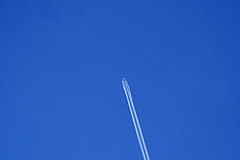I’ve bought a deck chair this Summer and it’s got me thinking. As I’ve sat in it – enjoying some peace until the moment when my children and ‘playing nicely together’ abruptly part company – I’ve been looking at the sky and thinking about space, distance and speed.

The view of the sky from my deck chair has many levels. First there are pigeons, flying between trees a few metres above me along little drooping arcs. Next are the red kites, effortlessly circling above, on the look out for carrion (I take care to move occasionally in my chair). Speeds are low. A pigeon, closely followed a sparrow hawk once zoomed just over my shoulder at thrilling speed, but away from the business of killing or eating, nothing moves fast.
Moving up in height, little propeller-driven planes from a nearby airfield are next. To me they resemble bumblebees – a quiet buzzing, slow progress. There are odd moments of drama when they perform acrobatics. When they dive straight to the ground they make a ‘Nazi-plane-shot-down-in-flames’ noise. The lowest section of their downward loop is hidden by houses and I find myself waiting for an explosion, but they always pull up again. So far. They move fast, 100s of kilometres an hour, but they are always at least a few kilometres away.
Next come the jet planes. A handy phone app allows me to quantify their height – the many many flights into or from nearby Heathrow are a few kilometres up, travelling at 300 kph. From a bedroom window I can sometimes see the flight path – multiple planes strung out across the evening sky as dots of light.
Some planes are not Heathrow bound, but are high, travelling from Ireland to Europe or Germany to America. These are ten kilometres or more above, little more than specks. Often the bit of the ground they are above is a surprisingly far distance away. If you want a view over a long distance, just look up into the sky. Without a geeky app to help, you can only tell these planes are there if they leave contrails, or via their lights at night. They are speeding along at 640 kph and the ratio of their distance to their speed is about the same as the little planes – so to me they move at much the same speed.
Higher things are only visible at night. The International Space Station is a rare visitor but it doesn’t stay long. At 370 kilometres height it is of course only a dot, but impressively fast as it tracks across the sky at 7.66 km/s, nearly 28,000 kph. It is 40 times further away than the jet planes, but moves nearly a hundred times faster. From my perspective, that’s about as fast as a circling red kite.
The fastest things in the sky are rare visitors: shooting stars. These little fragments – broken up planets or sweepings left over from the formation of the solar system – travel at ‘cosmic velocities’, around 30 kilometers a second (over 100,000 kph). Faster than the ISS they are also closer, burning up in the atmosphere at around 100 km in height. Like a sparrow hawk you can’t calmly measure their speed. Rather they are experienced as a sudden dramatic event, a glimpse into another, faster world.
I really like my deck chair.